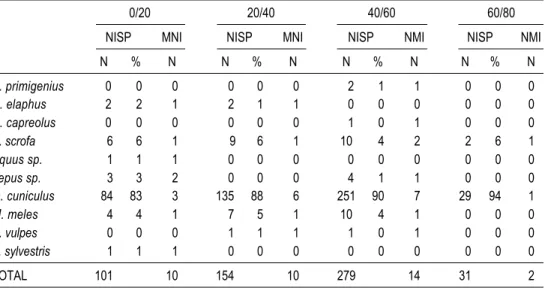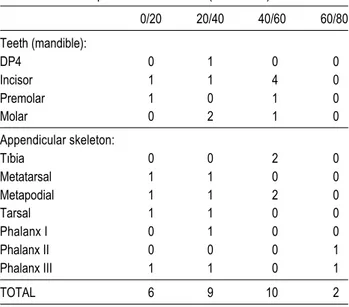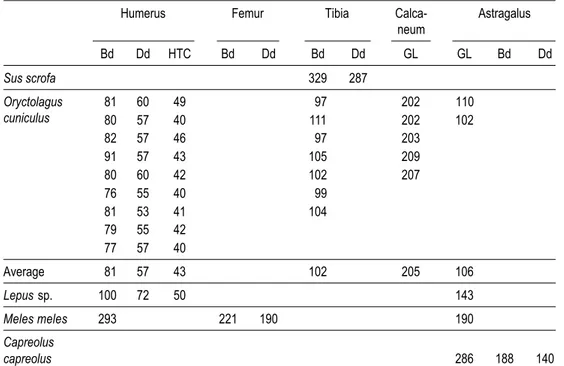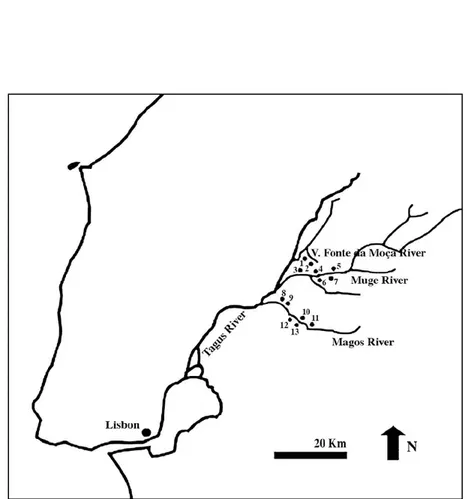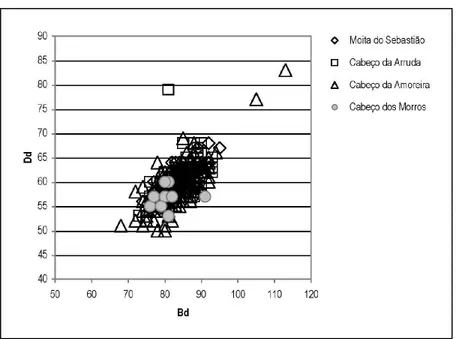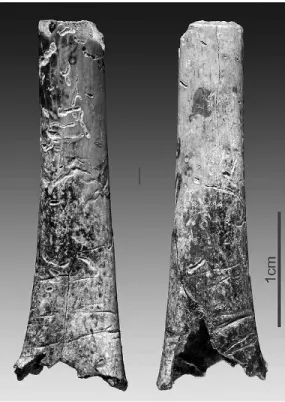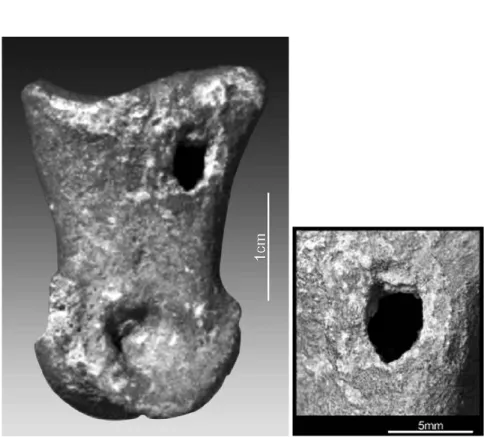Magos, in the lower Tagus valley, Portugal
Cleia Detry Instituto de Gestão do Património Arquitectónico e Arqueológico, I.P.
Introduction
This article discusses the vertebrate remains recovered from the Mesolithic shell midden of Cabeço dos Morros on the Magos River in the lower Tagus Valley, Portugal. It is the first publication on the fauna of the (Mesolithic) Tagus Shell Midden Complex of the Magos River. The Tagus shell middens are considered key sites for investigating the last hunter-gatherers of the Iberian Peninsula because they include some of the largest Mesolithic settlements in the region and altogether represent a significant period of occu-pation.
The Mesolithic is an interesting and complex period in Iberian prehistory because it bridges the period in which Upper Palaeolithic hunter-gatherers became Neolithic farmers and also because it extends over critical periods of environmental, demographic and social changes about which little is known.
The late Mesolithic of Portugal occurred within the Atlantic climate period, during the
optimum climaticum of the Holocene when high temperatures and the Flandrian
trans-gression produced large and deep estuaries. With the rapid rise in sea level, which began around 10,000 years ago and reached its maximum at c. 5000 years ago (Dias, 2004), the Tagus and its tributaries fell under a tidal influence as well as being flooded with brackish water. Salt marsh environments were established in the Muge valley around 6100 cal BC (Schriek, 2004). These changes probably promoted an increase in biodiversity within the Tagus estuaries, both terrestrial and aquatic, and must have provided Mesolithic hunter-gatherers with favourable subsistence conditions.
The significant changes in climate that arrived with the Early Holocene are thought to have had profound impacts on the subsistence practices and demography of Iberian Mesolithic peoples. Global warming probably contributed toward the demise of many eco-nomically important large animals, and promoted the increase of temperate species. Chang-ing distributions of plants and animals, in conjunction with improved expertise in huntChang-ing, gathering, food processing and food preservation enabled Mesolithic foragers to exploit a widening range of plants and animals. Demographic changes no doubt followed, in the form of population increases and changes in settlement patterns.
The Tagus Complex, which encompasses the Mesolithic shell middens of the Tagus tributaries of the Magos, Muge and Vale da Fonte da Moça Rivers, was discovered by Car-los Ribeiro during his 1863 survey of the Tagus Valley. It was then that he discovered Quinta da Sardinha at the source of the river Magos (Ribeiro, 1880). He subsequently discovered the nearby larger, now better-known, Muge River middens which gave their name to the Mesolithic complex of the Tagus estuaries. Ribeiro and his assistants excavated several Muge middens and in the course of the following 100 years a number of other excavations were carried out, the most notable being those of Correa (1933), Roche (1952, 1965) and Roche & Ferreira (1957). (For a detailed history of the excavations at these Mesolithic sites see Cardoso & Rolão, 2002/2003).
The archaeological importance of the Muge sites was recognised from the wealth of human remains that were interred within the middens. To date some 300 skeletons have been recovered, as well as a wealth of other archaeological material including abundant lithic industries (of which geometric microliths are the most notorious), bone tools, and fau-nal remains.
Altogether thirteen sites have been identified along the margins of three small tribu-taries of the Tagus, the Magos, Muge and Vale da Fonte da Moça rivers (see Fig. 1). The largest middens are those of the Muge Valley. Cabeço dos Morros, which is discussed here, is situated on the south bank of the river Magos. According to Paço (1938), Cabeço dos Morros was one of six Mesolithic sites on the Magos River originally discovered and named by Hipólito Cabaço in 1935. This site may possibly have been already recorded by C. Ribeiro under a different name. Unfortunately most of the Tagus shell middens have since been destroyed by ploughing.
Cabeço dos Morros is relatively intact although some of the upper layers appear to have been lost, leaving only 1,5 m of the original site (Paço, 1938). The lithic assemblage comprises flint, quartzite and quartz tools and includes microburins, scrapers and geome-trics (trapezes and a triangle) and was studied by José Manuel Rolão (1999). Cabeço dos Morros has yet to be carbon dated. Nevertheless, the lithic materials and faunal assem-blage place it firmly within the Mesolithic and suggest that it is related to, and contempo-rary with, the Muge shell middens.
New AMS dates obtained from the Muge shell middens by Roksandic (2006 and Roksandic et al., In prep) indicate that Mesolithic groups occupied that valley from at least
~6000 cal BC to ~5000 cal BC or later, with Cabeço da Arruda being the oldest and Cabeço da Amoreira the youngest. These new dates have important implications about demo-graphic, cultural and environmental factors faced by these Late Mesolithic peoples. Signifi-cantly, the new dates indicate that Mesolithic groups occupied the Muge Valley for a longer period than was previously thought, spanning a period comparable with the Mesolithic oc-cupations of the Sado River and Southwest Alentejo (see Table 1 for the listing of dates).
Moreover, the new dates indicate that, similar to the Mesolithic of the Sado region, the Muge Mesolithic persisted some 500 years after the arrival of the first farmers (after 5,500 cal BC) in the nearby Estremadura and Algarve (Zilhão, 2000). Finally, the new dates show that a substantial part of the latest Mesolithic occupations overlap with a period of escalating changes in the Tagus River environments (see van der Schriek, 2004).
Today Cabeço dos Morros is surrounded by cultivated rice fields but when the site was occupied by Mesolithic hunter-gatherers it was situated high up the estuary far from the sea. At present the site is 2.50 m above sea level. In years with high rainfall it is fre-quently flooded during the winter months, possibly providing a glimpse of how the site and its surrounding environment appeared when late Mesolithic groups occupied the valley.
Excavations at Cabeço dos Morros
Of the six Mesolithic Magos river sites identified by H. Cabaço in 1935, only two have been excavated: Cova da Onça and Cabeço dos Morros. Cova da Onça, located 5 km downstream from Cabeço dos Morros, was excavated in 1982 by Victor Gonçalves. Cabeço dos Morros was excavated between 1997 and 2001 in four campaigns directed by José Manuel Rolão.
Unlike the well-studied (Lentacker, 1986; Detry, 2007) faunal assemblages from the Muge middens, those of Cabeço dos Morros have only recently been examined (Detry, 2002/2003a). The apparent lack of interest in this assemblage is probably due to its small size and its relatively recent excavation.
Cabeço dos Morros was excavated in 2 m x 2 m squares that covered a total area of 800 m2. The squares were excavated in 20 cm artificial layers down to the sterile alluvial
layers at 80 cm deep. The top 20 cm was found to have been disturbed by agricultural activities.
Methodology
Only the vertebrates (and Crustaceans) were examined in this study. Sediments were colleted from each excavated context and water sieved through a 1 mm mesh to per-mit the recovery of both large and small bones, e.g. fish and amphibia. The faunal remains were first sorted into their larger taxonomic groups and subsequently mammal and bird remains were identified to species level.
Recording of bones and teeth followed criteria defined by Detry (2007), in accord-ance with Davis (1992). Identifications were made with the assistaccord-ance of the IGESPAR
Archaeozoology laboratory reference collection. Measurements of skeletal parts were taken with a digital calliper using von den Driesch (1976) parameters.
Results and discussion
Water sieving with a fine mesh allowed for the recovery of a wide size range of spe-cimens, from the tiny bones of amphibians and rodents to the large long bones of artiodac-tyls (Table 2). Mammals, amphibians and reptiles dominate the faunal assemblage, a pat-tern which contrasts with that observed by Lentacker (1986) for Cabeço da Arruda and Cabeço da Amoreira. This disparity is probably due to differences in recovery methods and highlights the importance of using a fine mesh when water screening.
Numerous rabbit (Oryctolagus cuniculus) bones were recovered; hare (Lepus sp.)
was also found but in smaller quantities (Table 3). Among the artiodactyls, wild boar (Sus scrofa) was the most common, followed by red deer (Cervus elaphus) and auroch (Bos primigenius). Roe deer (Capreolus capreolus) was represented by a single astragalus bone.
Equidae was represented by a single tooth which was too fragmented to enable identifi-cation to species.
Badger (Meles meles) was the third most common species. Two carnivores, red fox
(Vulpes vulpes) and wild cat (Felis sylvestris), were also present in low numbers.
Birds were represented by 7 bones (Table 4). Three of these were identified to spe-cies, including the coracoid of Columba livia (pigeon), the tibiotarsus of Corvus monedula
(jackdaw) and the humerus of Numenius arquata (curlew). The remaining four specimens
included a coracoid and radius identified as Anatidae (ducks and geese) and two
meta-carpals of Anas sp. (ducks). It is difficult to distinguish between Anatidae species but the
large size of the recovered duck bones suggests Anas platyrhynchos (mallard).
Several invertebrates, molluscs and a crustacean were also identified. Bivalve mol-luscs, mainly Scrobicularia plana (peppery furrow shell) and Cerastoderma edule (common
cockle) which were not examined in the present study, are reported elsewhere (Rolão, 1999). Crustaceans were dominated by a single species Carcinus maenas (common shore
crab).
Stratigraphic distribution
The faunal materials occur in greatest abundance at a depth of 40/60 cm. Fauna density increased steadily from the top layer down to 40/60. The lower 60/80 layer con-tained a substantially reduced density of fauna.
As seen in the profiles, a rich deposit of shells occurs in a layer defined by Rolão (2003) as a “dark shell layer”. This deposit appears to represent a single cultural layer. Because the site was excavated in artificial layers it is not possible to verify the matrices of origin of the fauna: whether they were recovered from the dark sand layer or from a super-ficial mixed layer.
Skeletal parts recovered
From the analyses of parts of the animal carcass represented it is sometimes pos-sible to make inferences about ancient human resource exploitation and sites use prac-tices. According to Binford (1978) the frequencies of skeletal parts of hunter-gatherer as-semblages can provide information about the way in which a site was used. He calculated an index using values related to meat, grease and marrow that showed which are the most valuable parts. Binford argued that hunting camps should contain higher frequencies of less valuable skeletal parts because the most valuable parts of the carcass were taken to base camps, which should therefore contain higher frequencies of valuable skeletal parts. Other authors like Brain (1969) and Lyman (1994) attribute the differences in frequencies of ana-tomical parts to erosion, which causes less dense bones being under-represented.
In the Muge river middens the pattern of skeletal part representation appears to have been mainly due to erosion (Detry, 2007). All parts of the carcass were observed to have been brought to the sites. However, at Cabeço dos Morros, wild boar distal limb bones are more common than at the Muge River sites (see Table 5) (Detry, 2007). This suggests that Cabeço dos Morros was used for different purposes than the Muge River sites. A do-minance of distal limb bones is usually understood to indicate the preparation of skins. However, according to Binford’s model, the presence of less valuable parts indicates the carcasses were prepared on site and subsequently removed to the base camps. Both ex-planations are not exclusive and at Cabeço dos Morros it is possible that preparation of both the skins and the carcasses happened simultaneously, with a selection of the more valuable parts of the carcass being taken to the base camps. This would agree with Rolão (1999) who suggested that this site acted as a support settlement for the relatively larger Muge sites.
However the bones that are present are also those with the greatest density, which may indicate the effects of erosion. For example Brain (1969) noticed that the distal tibia is one of the bones with a high percentage of survival, and Lyman (1994) noted that bones having the highest density values are the astragalus, calcaneum and distal tibia. Teeth are also resistant to erosion. For example, aurochs and Equus sp. are represented by teeth,
prac-tices due to their high density. Red deer are represented by a single pre-molar, proximal tibia, calcaneum and second phalanx.
For the wild boar numbers are slightly higher than red deer and aurochs. Boar is represented by 12 teeth and 15 bones; of these, two fragments are tibiae, two tarsals, 6 metapodials and 5 phalanges (Table 5).
The faunal assemblage from Cabeço dos Morros is altogether too small to allow a firm conclusion.
Osteometrics
Although the interpretation of the faunal assemblage is limited by the small sample size (Table 6) it is nevertheless possible to make useful osteometric interpretations of the results. As shown in Figures 2 and 3, which compare measurements on wild boar and rabbit bones from Cabeço dos Morros with those from the Muge shell middens, the os-teometric measurements of specimens from Cabeço dos Morros fell within the interval of values that Detry (2007) identified for specimens from the Muge shell middens. These patterns were expected because Cabeço dos Morros and the Muge shell middens were occupied for the same time span and possibly the same cultural group.
Condition of the bones
The majority of the small animal bones are well preserved. Those of the artiodactyls are highly fragmented, probably due to Mesolithic marrow-extraction practices, e.g. Fig. 4 shows a wild boar distal tibia with broken diaphysis. Bone marrow extraction is commonly practised by hunter-gatherers and is particularly visible in Mesolithic assemblages (Perez--Ripoll, 1992). Within the Muge complex almost all the bones are fractured (Detry, 2007) suggesting that this practice was highly common. The Cabeço dos Morros faunal remains also show the same pattern.
Only one bird bone, a humerus, was observed to have cut marks (Fig. 5). Approxi-mately 7% of all bones were burned (a value that may be inflated due to the small size of the sample). Punctures, like the one in Figure 6, are difficult to interpret as they may be due to marrow extraction or else carnivore activity. Davis (2002) also finds similar perfo-rated phalanges in the Solutrean levels of Caldeirão cave.
Unlike the fauna from the Muge Shell Middens, the fauna from Cabeço dos Morros was rarely covered by calcrete (superficial calcite concretions). This pattern may be due to the low concentration of shells found at this site compared with the Muge Shell Middens.
Also, studies on the Muge shell middens show that the occurrence of bone encrusted with such concretions usually increases with depth (Detry, 2002/2003a). Therefore the absence of calcrete on the Cabeço dos Morros bone calls into question Rolão’s (1999) suggestion that these contexts represent the deeper layers of a larger site.
Comparison of the faunal assemblage of Cabeço
dos Morros with those of other Muge complex sites
The range of taxa recovered from Cabeço dos Morros, and the fact that many of the taxa occur in very similar proportions (although smaller quantities) as in the Muge Shell Middens, does not support the interpretation of Cabeço dos Morros as a specialised bi-valve collecting settlement, as proposed by Rolão (1999). The recovery of few isolated hu-man remains (two teeth and a phalanx) indicates that, unlike the Muge Shell Middens, Cabeço dos Morros was not routinely used for human burials, Burials are abundant in the Muge sites, even in the top layers of the middens.
Altogether, the data presented here suggest that Cabeço dos Morros was used for short-term occupations. As stated earlier, the site is situated 2,5 m above sea level and becomes submerged during the winter rains. It is possible that similar conditions occurred during the Mesolithic, which would have caused the site to be inaccessible to people for part of the year. This scenario would explain the abundance of wetland species found at the site, e.g. amphibians and turtles. At present it is not possible to say whether these species represent Mesolithic food, are evidence of commensalism with humans, or repre-sent periods in which humans abandoned the site.
Low numbers of crustacean remains and fish bones were recovered at Cabeço dos Morros, a pattern that contrasts with the notably high quantities of crustacea and fish found in the Muge middens.
As stated, the most frequent mammal recovered from Cabeço dos Morros is the rabbit (83% to 94%). This pattern accords with those of other Estremadura and Tagus val-ley sites, such as the Tardiglacial levels from Picareiro (Bicho, 2000) or Caldeirão (Davis, 2002) caves, and Late Mesolithic shell middens (75% in Cabeço da Amoreira and 90% in Cabeço da Arruda – Detry, (2007).
Among artiodactyls the wild boar was the most abundant (6%) followed by red deer (2%) and auroch (<1%). These values differ from those of the Muge river sites where red deer dominated. It is particularly difficult to explain the low numbers of red deer because this species occupies similar habitats to wild boar, woodlands interspersed with open fields. Again, these values should be treated with caution due to the small size of the Cabeço dos Morros sample.
Carnivores are underrepresented at Cabeço dos Morros compared with the diver-sity and numbers found at the Muge sites (Lentacker, 1986; Detry, 2007). The dog (Canis familiaris) and iberian lynx (Lynx pardina) although present in late Mesolithic sites are not
present in this sample. Again, this may be an artefact caused by the small sample size.
Conclusions
This study of the Cabeço dos Morros fauna contributes to our understanding of the resource exploitation practices of Mesolithic hunter-gatherers in the Tagus river estuary. The interpretation of the faunal assemblage from Cabeço dos Morros was hampered by the small size of the sample and the fact that the site was excavated in artificial layers.
The fact that Cabeço dos Morros is a small site and contained particularly low den-sities of faunal remains suggests that it was occupied for short periods of time, perhaps intermittently. The fact that the site is situated at a low altitude and was therefore possibly flooded during the wetter months may explain the intermittent occupation.
Comparisons of the faunal assemblage of Cabeço dos Morros with those of the Muge river shell middens revealed the following similarities: the species present were co-incident with those found in the Muge middens; the rabbit was the most common mammal in Cabeço dos Morros, as in other middens. The Sado shell middens also have very simi-lar faunal assemblages to those of the Muge complex (Arnaud, 1987), as well has the same fracturing pattern (Detry, 2002/2003b).
Differences between Cabeço dos Morros and the Muge river shell middens were also observed, including the abundance of amphibians and rodents which seem to have been more common at Cabeço dos Morros. Furthermore, the proportions of artiodactyl species are different at Cabeço dos Morros where wild boar had higher frequencies than red deer, which only happens by a small difference in M. do Sebastião and significantly in Cabeço da Arruda middle layer. No human burials were found at Cabeço dos Morros. Breccia is almost absent from Cabeço dos Morros bone surfaces, unlike the Muge middens, suggest-ing that different post-depositional factors were affectsuggest-ing Cabeço dos Morros, such as the lower density of shells and smaller size of the archaeological site.
Acknowledgments
Sincere thanks to M. Wollstonecroft, S. Davis and A. F. Carvalho for reviewing the text and offering useful suggestions. Further thanks to J. Paulo Ruas for kindly providing the photographs of the bones.
Bibliography
BICHO, N.; HOCKETT, B.; HAWS, J. & BELCHER, W. (2000) – Hunter-gatherer subsistence at the end of the Pleistocene: preliminary results from Picareiro Cave, Central Portugal. Antiquity, 74: 500-506.
BINFORD, L. (1978) – Nunamiut Ethnoarchaeology. New York: Academic Press.
BRAIN, C. K. (1969) – The contribution of Namib desert Hottentots to an understanding of Australopithecine bone accumulations. Scient. Pap. Namib Desert Res. Stn., 39: 13-22.
CARDOSO, J. L. & ROLÃO, J. M. (2002/2003) – Prospecções e escavações nos concheiros mesolíticos de Muge e de Magos (Salvaterra de Magos): Contribuição para a história dos trabalhos arqueológicos efectua-dos. Muge. Estudos Arqueológicos, 1: 7-169.
CORRÊA, A. M. (1933) – Les nouvelles fouilles à Muge (Portugal). XV Congrès International d’Anthropologie & d’Archéologie Préhistorique, pp. 357-372. Paris.
DAVIS, S. (1992) – A rapid method for recording information about mammal bones from archaeological sites,
pp. 1-14. London, Ancient Monuments Laboratory.
DAVIS, S. (2002) – The mammals and birds from the Gruta do Caldeirão, Portugal. Revista Portuguesa de Arqueologia, 5 (2): 29-98.
DETRY, C. (2002/2003a) – Estudo Arqueozoológico de um contexto do Mesolítico Final no Paúl de Magos – Cabeço dos Morros (Salvaterra de Magos, Portugal). Trabalho de introdução à investigação
histórico-arqueo-lógica, Universidade Autónoma de Lisboa e Universidade de Salamanca, Lisboa.
DETRY, C. (2002/2003b) – Estudo Arquezoológico de um concheiro mesolítico do Sado – Cabeço do Pez (Alcácer do Sal, Portugal). Trabalho de introdução à investigação histórico-arqueológica, Universidade
Autó-noma de Lisboa e Universidade de Salamanca, Lisboa.
DETRY, C. (2007) – Paleoecologia e Paleoeconomia do Baixo Tejo no Mesolítico Final: O contributo do estudo dos mamíferos dos concheiros de Muge. Tese de doutoramento. Universidade de Salamanca e Universidade
Autónoma de Lisboa.
DIAS, A. (2004) – A história da evolução do litoral português nos últimos vinte milénios. Colóquio sobre Evo-lução Geohistórica do Litoral Português e Fenómenos Correlativos, pp. 157-170. Lisboa.
DRIESCH, A. v. d. (1976) – A Guide to the measurement of animal bones from archaeological sites. Harvard:
Harvard University. (Peabody Museum Bulletin, 1).
HUGHEN, K. A.; BAILLIE, M. G. L.; BARD, E.; BAYLISS, A.; BECK, J. W.; BERTRAND, C. J. H.; BLACKWELL, P. G.; BUCK, C. E.; BURR; G. S.; CUTLER, K. B.; DAMON, P. E.; EDWARDS, R. L.; FAIRBANKS, R.; FRIEDRICH, M.; GUILDERSON, T. P.; KROMER, B.; McCORMAC, G.; MANNING, S.; RAMSEY, C. B.; REIMER, P. J.; REIMER, R. W.; REMMELE, S.; SOUTHON, J. R.; STUIVER, M.; TALAMO, S.; TAYLOR, F. W.; van der PLICHT, J. & WEYHENMEYER, C. E. (2004) – Marine04 Marine Radiocarbon Age Calibration, 0-26 cal kyr BP. Radiocarbon, 46 (3): 1059-86.
LENTACKER, A. (1986) – Preliminary results of the fauna of Cabeço da Amoreira e Cabeço da Arruda (Muge, Portugal). Trabalhos de Antropologia e Etnologia, 26 (1-4): 9-26. Sociedade Portuguesa de Antropologia e
Etno-logia.
PAÇO, A. (1938) – Novos concheiros do vale do Tejo. Brotéria, 27 (1): 66-75.
PÉREZ-RIPOLL, M. (1992) – Marcas de carníceria, fracturas intencionadas y mordeduras de carnívoros en huesos prehistóricos del Mediterrânico Espanol. Alicante: Instituto de Cultura Juan Gil-Albert.
REIMER, P. J.; BAILLIE, M. G. L.; BARD, E.; BAYLISS, A.; BECK, J. W.; BERTRAND, C. J. H.; BLACKWELL, P. G.; BUCK, C. E.; BURR; G. S.; CUTLER, K. B.; DAMON, P. E.; EDWARDS, R. L.; FAIRBANKS, R.; FRIEDRICH, M.; GUILDERSON, T. P.; HOGG, A. G.; HUGHEN, K. A.; KROMER, B.; McCORMAC, G.; MAN-NING, S.; RAMSEY, C. B.; REIMER, R. W.; REMMELE, S.; SOUTHON, J. R.; STUIVER, M.; TALAMO, S.; TAYLOR, F. W.; van der PLICHT, J.; WEYHENMEYER, C. E. (2005) – IntCal04 Terrestrial Radiocarbon Age Calibration, 0-26 cal kyr BP. Radiocarbon, 46 (3): 1029-58.
ROCHE, J. & FERREIRA, O. da V. (1957) – Nota sobre a estratigrafia dos concheiros de Muge. Comunica-ções dos Serviços Geológicos, 37: 261-268.
ROCHE, J. (1952) – Les fouilles des amas coquilliers de Muge. Boletim da Sociedade Geológica de Portugal,
10: 145-152.
ROCHE, J. (1965) – Données récentes sur la stratigraphie et la chronologie des amas coquilliers d’âge méso-lithique de Muge (Portugal). Quaternaria, VII: 5.
ROKSANDIC, M. (2006) – Analysis of burials from the new excavations of the sites Cabeço da Amoreira and Cabeço da Arruda (Muge, Portugal). In N. F. Bicho & A. F. Carvalho (Eds.), Do Epipaleolítico ao Calcolítico. Actas do IV Congresso de Arqueologia Peninsular, pp. 43-54. Faro: Universidade do Algarve, Centro de Estudos
do Património. (Promontoria Monográfica, 4).
ROLÃO, J. M. (1999) – Del Würm Final al Holocénico en el Bajo Valle del Tajo. Complejo arqueológico meso-lítico de Muge. Tese de Doutoramento. Faculdade de Geografia e História, Universidade de Salamanca,
Sala-manca.
ROLÃO, J. M. (2003) – Relatório de escavações do Cabeço dos Morros. Relatório entregue ao IGESPAR.
SCHRIECK, T. van der (2004) – Holocene environmental change and the alluvial geoarchaeology of Mesolithic settlement-subsistence in the Muge and Magos valleys, lower Tagus basin, Portugal. Tese de Doutoramento.
University of Newcastle upon Tyne. School of Geography, Politics and Sociology. Newcastle.
STUIVER, M. & REIMER, P. J. (1993) – Extended 14C Data Base and revised CALIB 3.0 14C Age Calibration.
Radiocarbon, 35 (1): 215-30.
UMBELINO, C: (2006) – Outros Sabores do Passado. As análises de oligoelementos e de isótopos estáveis na reconstituição da dieta das comunidades humanas do Mesolítico Final e do Neolítico Final / Calcolítico do território português. Tese de Doutoramento. Faculdade de Ciências e Tecnologia, Universidade de Coimbra,
Coimbra.
ZILHÃO, J. (2000) – From the Mesolithic to the Neolithic in the Iberian peninsula. In T. Douglas Price (Ed.), Eu-rope’s First Farmers, pp. 144-182. Cambridge: Cambridge University Press.
TABLE 2. Comparison of the results of the present study on Cabeço Morros with data published by Lentacker (1986) for two sites of Muge shell-middens. The table shows the number of fragments recovered by class and archaeological layer.
Layer Lentacker (1986)
0/20 20/40 40/60 60/80 Total C. Amoreira C. Arruda
Birds 6 31 6 1 44* 220 69
Mammals 262 405 601 43 1311* 42682 9429
Amphibia & Reptiles 36 112 269 3 420* 748 29
Fish 6 7 25 4 42* 3511 458 Crustacean 21 22 19 0 62* 10419 1041 Bivalves 374* 28123 1437 Gastropods 43* 2644 232 Undetermined 228 492 1041 100 1861* TOTAL 559 1069 1961 151 3740* 88347 12695
* J. M. Rolão, pers. com.
TABLE 3. Number of identified specimens (NISP) and minimum number of individuals (NMI) of mammals, by archaeological layer and species.
0/20 20/40 40/60 60/80
NISP MNI NISP MNI NISP NMI NISP NMI
N % N N % N N % N N % N B. primigenius 0 0 0 0 0 0 2 1 1 0 0 0 C. elaphus 2 2 1 2 1 1 0 0 0 0 0 0 C. capreolus 0 0 0 0 0 0 1 0 1 0 0 0 S. scrofa 6 6 1 9 6 1 10 4 2 2 6 1 Equus sp. 1 1 1 0 0 0 0 0 0 0 0 0 Lepus sp. 3 3 2 0 0 0 4 1 1 0 0 0 O. cuniculus 84 83 3 135 88 6 251 90 7 29 94 1 M. meles 4 4 1 7 5 1 10 4 1 0 0 0 V. vulpes 0 0 0 1 1 1 1 0 1 0 0 0 F. sylvestris 1 1 1 0 0 0 0 0 0 0 0 0 TOTAL 101 10 154 10 279 14 31 2
TABLE 4. Number of identified specimens (NISP) for bird bones. 0/20 20/40 40/60 60/80 Anatidae 0 1 1 0 Anas sp. 1 0 1 0 Columba livia 0 0 1 0 Corvus monedula 0 0 0 1 Numenius arquata 0 0 0 1 TOTAL 1 1 3 2
TABLE 5. Skeletal parts of the wild boar (Sus scrofa ).
0/20 20/40 40/60 60/80 Teeth (mandible): DP4 0 1 0 0 Incisor 1 1 4 0 Premolar 1 0 1 0 Molar 0 2 1 0 Appendicular skeleton: Tíbia 0 0 2 0 Metatarsal 1 1 0 0 Metapodial 1 1 2 0 Tarsal 1 1 0 0 Phalanx I 0 1 0 0 Phalanx II 0 0 0 1 Phalanx III 1 1 0 1 TOTAL 6 9 10 2
TABLE 6. Measurements of mammal skeletal parts.
Humerus Femur Tibia Calca- Astragalus
neum Bd Dd HTC Bd Dd Bd Dd GL GL Bd Dd Sus scrofa 329 287 Oryctolagus 81 60 49 97 202 110 cuniculus 80 57 40 111 202 102 82 57 46 97 203 91 57 43 105 209 80 60 42 102 207 76 55 40 99 81 53 41 104 79 55 42 77 57 40 Average 81 57 43 102 205 106 Lepus sp. 100 72 50 143 Meles meles 293 221 190 190 Capreolus capreolus 286 188 140
FIGURE 1. Mesolithic shell-middens in the lower Tagus Valley. 1 – Vale da Fonte da Moça I; 2 – Vale da Fonte da Moça II; 3 – Flor da Beira; 4 – Fonte do Padre Pedro; 5 – Cabeço da Arruda; 6 – Moita do Sebastião; 7 – Cabeço da Amoreira; 8 – Cova da Onça; 9 – Monte dos ossos; 10 – Magos de Cima; 11 – Cabeço da Barragem; 12 – Cabeço dos Môrros; 13 – Magos de Baixo. Adapted from Paço (1938).
FIGURE 2. Comparison of wild boar distal tibia measurements from Cabeço dos Morros and the Muge river middens.
FIGURE 3. Comparison of rabbit distal humerus measurements from Cabeço dos Morros and the Muge river middens.
FIGURE 4. Distal tibia of wild boar (Sus scrofa) with a fractured diaphyses,
sug-gesting bone marrow extraction.
FIGURE 6. Red deer (Cervus elaphus) second phalanx with a hole of unknown origin, possibly of human
